
- Home
- Artist
- David Bates (3)
- David Snyder (4)
- F E. Jamieson (3)
- Francis E. Jamieson (3)
- Giovanni Demartino (3)
- Illegible Signature (10)
- Jean-michel Basquiat (3)
- John S. Barrows (4)
- Keith Haring (2)
- Lovejoy (3)
- Morgan (2)
- Mystery Artist (6)
- Otterman (3)
- Pablo Picasso (15)
- Remedios Varo (4)
- See Description (30)
- See Photos (3)
- Signed (4)
- Signed On The Back (2)
- Unknown (42)
- ... (4675)
- Material
- Signed
- Title
- Type
- Acoustic (9)
- Baskets (9)
- Bowls (11)
- Boxes (46)
- Furniture (14)
- Kitchen Equipment (25)
- Marquee Sign (13)
- Metal & Ironwork (31)
- Painting (190)
- Paintings (14)
- Plaque (20)
- Plaques / Signs (18)
- Pottery (13)
- Print (22)
- Sculpture (13)
- Sign (45)
- Signs (76)
- Street Sign (19)
- Tools (11)
- Wooden Sign (9)
- ... (4216)
- Unit Of Sale
Antique Old Antebellum South American Folk Art Pre Civil War Sampler, 1855
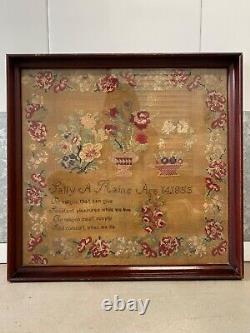
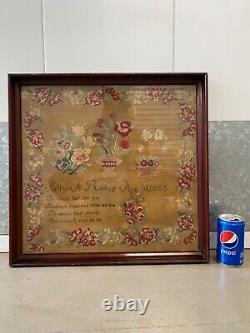
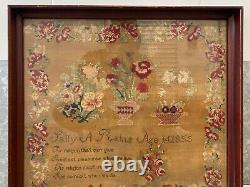
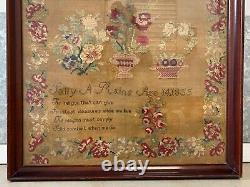
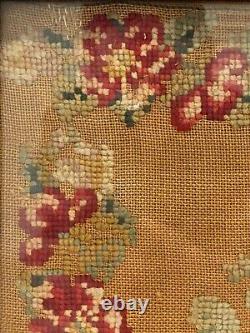
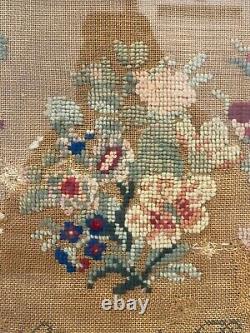

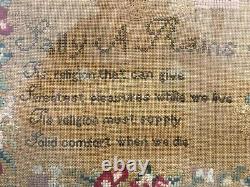
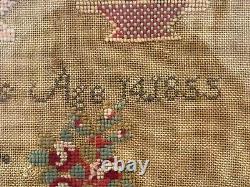





This is a finely embroidered and RARE Antique Old Antebellum South American Folk Art Pre Civil War Sampler, created by a fourteen-year-old girl named Sally A. Through my research, the "Rains" surname was most prevalent in the Southern United States at this time, especially in Kentucky, Georgia, North Carolina, and Arkansas, according to census and church records.
The old woman I acquired this from said that she had bought it years ago at Brimfield. Rains's birth year would have been 1841, but unfortunately, I have not been able to find any information on her. Perhaps you know more about the young artist of this work? This work reads: Sally A. " Additionally, there is a hymnal quote, written by Mary Masters in 1773 which reads: "Tis religion that can give Sweetest pleasures while we live.Tis religion must supply Solid comfort when we die. This was a popular quote with Stone-Campbell Christian revival movement of the 19th century, which was originally founded in Kentucky, Pennsylvania and West Virginia. Approximately 16 3/4 inches tall x 17 1/4 inches wide including frame. Actual artwork is approximately 15 1/2 inches tall x 16 1/4 inches wide. Very good condition for age, with a few small and unnoticeable old tears please see photos.
This fantastic and early sampler is priced to sell. If you like what you see, I encourage you to make an Offer. Please check out my other listings for more wonderful and unique artworks!
Hymnals of the Stone-Campbell Movement. Illinois and the Stone-Campbell Movement. The nineteenth century witnessed the birth of a church reform movement that has come to be known as the "Restoration Movement" or the Stone-Campbell Movement.
Leaders in this movement did not seek to establish yet another denomination, instead, they hoped to unite Christians from all the denominations. This goal was not to be realized, however, and independent congregations began to spring up.
The first churches to identify themselves as "Christian Churches, " Disciples of Christ, " or "Churches of Christ, were located mostly on the frontier of the country: Kentucky, western Pennsylvania, Ohio, and western Virginia. As settlers moved west, the movement followed. The first church established in Illinois by members of this emerging brotherhood of churches was the Barney's Prairie Christian Church, in Wabash County in July of 1819. In August, a second congregation was established at Coffee Creek, near Keensburg in Wabash County. Stone, one of the four primary pioneers of the movement, labored in Kentucky from 1796 until the 1830s.Repelled by the slave-holding society of that state, he moved his family to Jacksonville, Illinois, from Kentucky in 1834. Here he resided until his death in 1844, editing his paper. His experience typified many members of the Christian Church in the decades between 1830 and 1860; most who moved into the state were anti-slavery, except those who came from southern Indiana. When the political parties restructured in 1861, most of these Christians who had been Whigs, settling in central Illinois, became Republicans and most who had been Democrats, settling in southern Illinois, followed Douglas until the Confederate states seceded.
Yet, even then, the vast majority remained loyal to the Union, with only about 10% siding with the South. As the population of the state grew, so did the size and number of churches.
The 1850 census listed Illinois as having a total population of 851,470. In 1848, 69 churches of the Stone-Campbell Movement in Illinois recorded a total membership of 11,636.By 1860, while the state reported a population of 1,711,942, the number of churches had doubled to 148. While that may not seem like a large number of congregations today, it must be kept in mind that there were only three states (Ohio: 365, Indiana: 347, and Kentucky: 304) boasting more churches in the Stone-Campbell Movement-with a total of only 2,068 congregations nationally. This spreading movement touched the lives of all residents of the frontier, and indirectly influenced all of the United States.
Abraham Lincoln's father and stepmother lived among Scotch Baptists in Kentucky (congregations which eventually associated themselves with the Stone-Campbell Movement). When they moved to Indiana, they became members in one of those churches.
After moving to Macon County, Illinois, in 1831, they placed their membership in the Christian Church there. These churches also provided higher education in the state, establishing colleges at Abingdon in 1853, Jacksonville in 1854, and Eureka in 1855. After the University of Chicago was established in 1890, these churches established the country's first University Bible Chair there in 1894. Churches were an integral part of life on the frontier.The doctrine of the Stone-Campbell Movement dictated their worship style, eventually fragmenting their unity over the use of musical instruments, choirs, even the use of hymnals containing musical notation. Early in their history, they adapted contemporary hymns, altering offending words or phrases.
But as the movement grew, gifted men and women wrote new hymns and new tunes reflecting their doctrinal concerns. These included such prominent favorites as. God will Take Care of You. Since Jesus Came into My Heart.
Illinois produced a fair number of these writers: at least fifteen authors connected with Illinois contributed works to the hymnals in this collection. Silas White Leonard of Centralia was a leading sponsor of the "singing school movement" of the mid-1800s.This movement swept the frontier; congregations and towns with hitherto poor-quality singing invited these skilled song leaders to conduct singing classes (usually in a local church) at a reasonable cost. Hymns as well as popular songs formed the instructional core. This unique collection is a repository of the emotional outpourings of a significant segment of American society over a period of generations.
Songs were popular entertainment on the frontier. These included hymns and gospel-songs because church membership was viewed as normative and indispensable by a large portion of the population at that time. While collected sermons may be the best storehouse of a people's doctrinal statements, they only represent the emotional and spiritual output of the clergy in a given place and time.
Hymns, sung weekly and with fervor, capture the essence of heart-felt religious expression, and represent an arena of participation that has always been open to the vast majority of church members. This web site provides access to some of the hymns that were popular during the early years of the Stone-Campbell Movement as it spread across the frontier and into Illinois.

